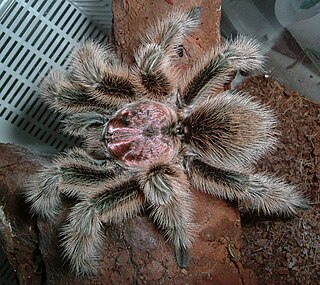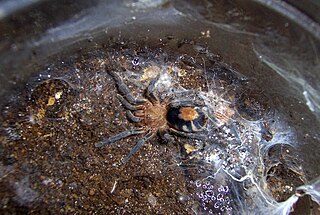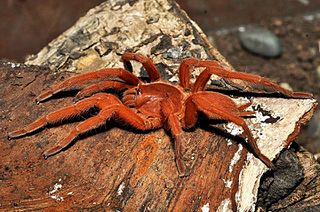
Brachypelma is a genus of spiders in the family Theraphosidae (tarantulas). They may have bodies up to 6 cm long with legs of similar or greater lengths. Some species have brightly colored legs, with red or orange marks and rings.

Grammostola is a genus of South American tarantulas that was first described by Eugène Louis Simon in 1892. These medium to large sized spiders are native to tropical South America, and are usually brown in color, with pinkish or orangish-red hairs. The very docile Chilean rose tarantulas are popular as a beginner's spider among tarantula enthusiasts.

Selenocosmia is a genus of tarantulas that was first described by Anton Ausserer in 1871.
Euathlus is a genus of South American tarantulas that was first described by Anton Ausserer in 1875. It is a senior synonym of Paraphysa, and was formerly considered a senior synonym of Brachypelma, but this was later rejected.

Tarantulas comprise a group of large and often ″hairy″ spiders of the family Theraphosidae. Currently, about 1,000 species have been identified. The term tarantula is usually used to describe members of the family Theraphosidae, although many other members of the same infraorder (Mygalomorphae) are commonly referred to as "tarantulas" or "false tarantulas". Some of the more common species have become popular in the exotic pet trade. Many New World species kept as pets have urticating hairs that can cause irritation to the skin, and in extreme cases, cause damage to the eyes.

The skeleton tarantula, Ephebopus murinus, is a species of spider belonging to the family Theraphosidae (tarantulas), sub-family Aviculariinae. A New World species, it is native to several South American countries. Its common name is derived from the skeleton-like markings on its legs.

Cyriocosmus is a genus of tarantulas that was first described by Eugène Louis Simon in 1903.

Ephebopus is a genus of northeastern South American tarantulas that was first described by Eugène Louis Simon in 1892. Its relation to other tarantulas is one of the most uncertain in the family, and it has been frequently moved around and has been placed in each of the eight subfamilies at least once.

The Malaysian earthtiger tarantula, scientific name Omothymus schioedtei, is a species of spider in the family Theraphosidae (tarantulas), found in Peninsular Malaysia. It is also known by the synonym Cyriopagopus schioedtei.

Cyriopagopus is a genus of southeast Asian tarantulas found from Myanmar to the Philippines. As of March 2017, the genus includes species formerly placed in Haplopelma. It was first described by Eugène Louis Simon in 1887.
Orphnaecus is a genus of tarantulas that was first described by Eugène Louis Simon in 1892. They have close to fifty lanceolate stridulatory spines on the chelicerae, known as "strikers". The male embolus has a single strong retrolateral keel. It is considered a senior synonym of Chilocosmia and Selenobrachys.
Orphnaecus dichromatus is a species of selenocosmiine tarantula, in the Phlogiellini tribe.

Orphnaecus philippinus, known as the Philippine tangerine, is a species of tarantula. It is native to the Philippines.
Lyrognathus is a genus of Asian tarantulas that was first described by Reginald Innes Pocock in 1895.

Phlogiellus is a genus of tarantulas that was first described by Reginald Innes Pocock in 1897.
Coremiocnemis is a genus of tarantulas that was first described by Eugène Louis Simon in 1892.
Crassicrus is a genus of Central and South American tarantulas that was first described by S. B. Reichling & R. C. West in 1996.
Selenotholus is a monotypic genus of tarantulas containing the single species, Selenotholus foelschei. It was first described by Henry Roughton Hogg in 1902, and is found in the Northern Territory. It is distinguished from Selenocosmia in by a thoracic fovea recurved, along with the first and fourth pairs of legs being of equal size.
Rick C. West is a Canadian arachnologist with a main expertise toward tarantula spiders. West was born in Victoria, British Columbia. He has been interested in spiders since childhood, and collected his first tarantula, Aphonopelma eutylenum at the age of 13. He worked primarily as a Chief Constable for a local Animal Humane Society, but also have been involved with the collecting, breeding, rearing and photography of theraphosid spiders. West has traveled to over 27 countries to document and study them in their environment, has been a host, presenter and co-producer in several tarantula documentaries and has also described several new species.

The Selenocosmiinae are a subfamily of tarantulas found in South-East Asia and Australia.










